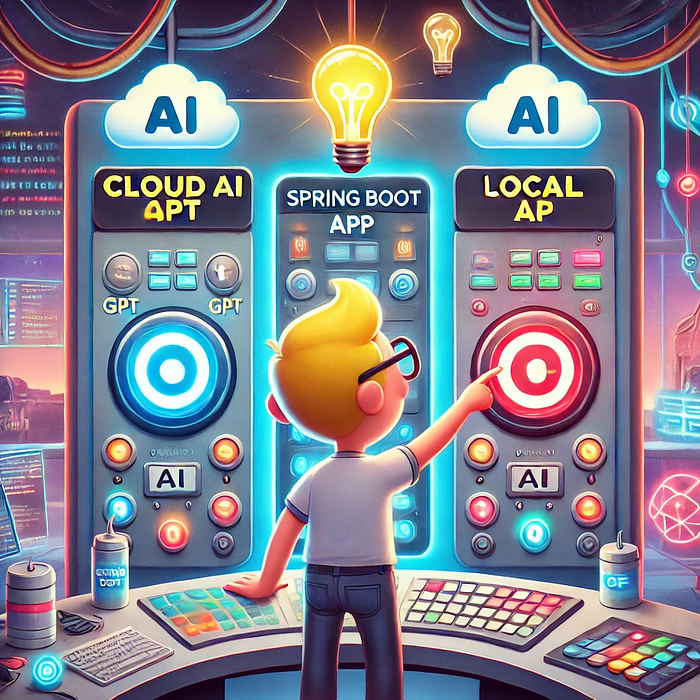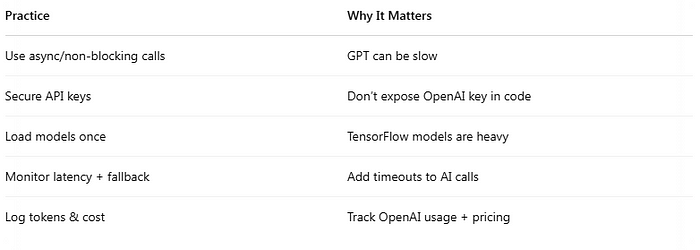Integrating AI Magic into Spring Boot: Harnessing OpenAI and TensorFlow for Smarter Applications
 Chant Khialian
Chant KhialianTable of contents
- Why Bob Is Bringing AI Into Spring Boot
- Architecture Overview
- Integrating OpenAI API in Spring Boot
- Step 1: Add OpenAI Client (via WebClient or SDK)
- Step 2: Call GPT from a Service
- Add TensorFlow Dependency
- Example: Sentiment Classification
- Combining AI Sources (OpenAI + TF)
- Best Practices
- Security Tip
- Use Case Ideas
- Find us

Why Bob Is Bringing AI Into Spring Boot
Bob’s building a customer support system that can:
Instead of building models from scratch, Bob uses:
OpenAI API for LLMs (GPT-like magic)
TensorFlow Java for local ML inference
Architecture Overview
[Client]
⬇️
[Spring Boot API]
⬇️⬇️
[OpenAI API] ← LLM tasks (chat, summarization)
[TensorFlow] ← In-house models (sentiment, image tags)
Bob’s API acts as a smart gateway, combining cloud-based AI with local model inference.
Integrating OpenAI API in Spring Boot

Step 1: Add OpenAI Client (via WebClient or SDK)
@Configuration
public class OpenAIConfig {
@Bean
public WebClient openAIClient() {
return WebClient.builder()
.baseUrl("https://api.openai.com/v1")
.defaultHeader("Authorization", "Bearer " + System.getenv("OPENAI_API_KEY"))
.build();
}
}
Step 2: Call GPT from a Service
@Service
public class GPTService {
@Autowired
private WebClient openAIClient;
public Mono<String> getChatResponse(String prompt) {
return openAIClient.post()
.uri("/chat/completions")
.bodyValue(Map.of(
"model", "gpt-3.5-turbo",
"messages", List.of(Map.of("role", "user", "content", prompt))
))
.retrieve()
.bodyToMono(String.class);
}
}
Supports:
Integrating TensorFlow Java for Local ML Inference

Add TensorFlow Dependency
<dependency>
<groupId>org.tensorflow</groupId>
<artifactId>tensorflow-core-platform</artifactId>
<version>0.4.0</version>
</dependency>
Example: Sentiment Classification
public class SentimentService {
private SavedModelBundle model;
public SentimentService() {
model = SavedModelBundle.load("models/sentiment", "serve");
}
public String predict(String inputText) {
try (Tensor<String> input = Tensors.create(inputText)) {
Tensor result = model.session().runner()
.feed("input_text", input)
.fetch("output_label")
.run().get(0);
return result.expect(String.class).data().getObject();
}
}
}
Use cases:
Combining AI Sources (OpenAI + TF)

Bob builds an endpoint that:
Uses GPT to summarize a chat
Then uses TensorFlow to classify sentiment
Finally stores it in a database
@PostMapping("/analyze")
public ResponseEntity<ChatAnalysis> analyze(@RequestBody String message) {
String summary = gptService.getChatResponse("Summarize: " + message).block();
String sentiment = sentimentService.predict(message);
return ResponseEntity.ok(new ChatAnalysis(summary, sentiment));
}
Best Practices

Security Tip
Use server-side proxying for GPT, not direct calls from frontend. This protects:
Use Case Ideas

Find us
linkedin Shant Khayalian
Facebook Balian’s
X-platform Balian’s
web Balian’s
Youtube Balian’s
#springboot #openaiapi #tensorflowjava #javaml #machinelearning #gptintegration #aiinjava #springai #backendai #microservices
Subscribe to my newsletter
Read articles from Chant Khialian directly inside your inbox. Subscribe to the newsletter, and don't miss out.
Written by
